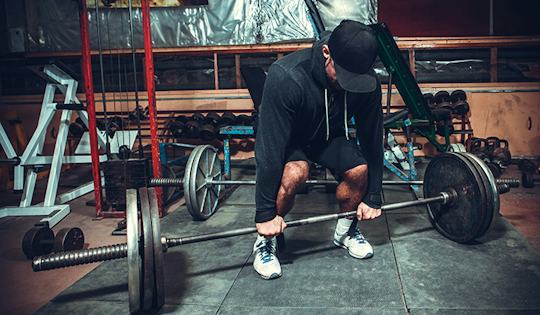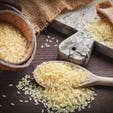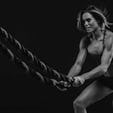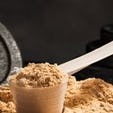The hinge is one of the Essential movements required for all sports and activities. In my previous article “4 Essential Bodyweight Movements Everyone Should Master,” I discussed the importance of the hinge in strengthening the posterior chain, from the upper and mid back muscles, to the lower back, glutes, hamstrings and calves.
One of the most popular hinging movements is the Deadlift. The Deadlift is one of my personal favorite exercises for building a strong base of brute strength. Plus, there’s nothing that makes you feel more like a BOSS than pulling a heavy load off the floor.
But progressing in the Deadlift isn’t always as simple as loading up the bar with more weight. Having a great program with proper volume of load and reps will help, but you also should consider using auxiliary and sometimes unconventional exercises to supplement and enhance your training.
These exercises aren’t necessarily going to allow you to carry the heaviest of loads, but that is not the point of these movements. The point of these movements are to enhance your primary exercises by rooting out muscular imbalances and also strengthening areas that are needed to support your primary exercises.
Since the primary movement is a hinge, lets start with a hinge specific movement.
Improve Your Deadlift with the Weighted Single Leg Deadlift
The first time I experienced working with this exercise was back in 2002 when I worked closely with a physical therapist. We used this exercise unweighted in rehabilitation protocols for various injuries from the lower leg up through the hips. But it really becomes a great full body exercise when front loaded.
This exercise can be done with your Bodyweight, Kettlebells or an Onnit Sandbag.
Beginners should start the exercise without weight from a standing position with the shoulders pulled back and core muscles engaged. Make sure the spine is stacked from head to hips. Intermediate lifters can try it weighted.
Lift one leg and hinge at the hips, with a slight bend in the standing knee. Let the hands dangle in front of you as you hinge forward. Hinge as far as you can comfortably while maintaining balance, keeping your hips even.
Your hips must resist rotation through activation of the opposite glutes, core muscles, back and hip flexors all working in unison. The hips in most athletes will have a tendency to drop towards the side where the leg is raised. As a coach, pay particular attention to this with your athletes.
There are various progressions depending on the ability of the individual athlete. Some of your athletes will be unable to reach the ground and therefore will need to hinge to a bench or low box initially. Once your athlete gains the stability and balance needed to go further, they can progress to lower points.
*Note: progressing to weights can include using various tools which will make the hinge endpoint different heights depending on the tool. For example, you’ll hinge further with Dumbbells and Sandbags, versus using a Kettlebell.
You can try various weighted versions demonstrated here with the Onnit Sandbag:
- Holding the Sandbag away from the body.
- Holding the Sandbag close to the body.
- Hinge with additional knee bend.
Working on this exercise on a regular basis will help root out the body’s imbalances across the hips and transfer into better stability throughout your more conventional Deadlift.
Improve Your Deadlift with Front Weighted Good Mornings
Good Mornings are a great exercise for strengthening the posterior chain muscles; hamstrings, glutes and back muscles.
The Steel Club:
- Stand with your feet hip width apart with a slight bend at your knee, holding a Steel Club in your mid-line close to your sternum. Keeping your back side fixed, rotate at your hips so as to bring shoulders towards the floor. Stop with your chest above parallel with the floor. Keep the Steel Club in a consistent relationship with your body. Maintaining a strong core, return back to a standing position.
The Kettlebell:
- Hold the Kettlebell by the sides of the handle (horns) and bring it snugly against the chest. Engage the Back by squeezing the shoulder blades together. Begin to hinge at the hips, pushing your butt back until your upper body is parallel to the floor. Then raise your upper body back upwards to the start position.
The Sandbag:
- Hold the Sandbag in the racked position; the same position that you would begin a Zercher Squat. The hands should be pulling apart from center and the shoulder blades squeezed together with your chest open. Follow the same steps to hinge as the Kettlebell Good Morning.
One of the advantages I believe that the Steel Club, Kettlebell or Sandbag Goodmornings have over the more conventional Barbell Goodmorning is the positioning of the load.
Check it out… When the bar is on your back, we definitely activate the upper back muscles to secure the bar, however in the case of Sandbags or Kettlebells, you can change the position of the weight for the Goodmorning to the front as opposed to the back.
The load will be less than you could place on a bar, but with the weight now loaded in the front of the body your back will have to remain engaged to keep the weight from dropping as you hinge forward. The exercise will require constant activation of many of the same muscles you’ll use during your Deadlift.
Your shoulders, back, biceps and hands will all need to be engaged in order to secure the weight and maintain posture. The same is true for the Kettlebell Good Morning. Supplementing your routine with this movement will help provide you with more stability, thereby improving your Deadlift over the long term.
Improve Your Deadlift with Bent Over Sandbag Rows
Superior back strength is essential if you want to put up big Deadlift numbers. The shoulders and upper back must remain engaged. The mid and lower back must maintain tension in order to protect the spine as you pull from the floor.
I like to supplement my conventional Bent Over Rows with an Olympic Bar for Sandbag Rows for various reasons.
Firstly, with the sandbag I’m able to use the top handles for close grip rows and engage the center of the back more. I can also pull further than I would be able to with a bar, getting a deeper muscular contraction.
Secondly, I can use the outer handles to change the angle and work the upper back, traps and rear deltoids more. The bag flexes and allows me to engage those muscles even more than a bar would because the bar stops at my chest and doesn’t flex.
Thirdly, I can forgo the handles and simply squeeze the bag with my hands to work on grip strength. This is one key element that is often overlooked with the Deadlift. You’re only as strong as your grip. I don’t use straps (ever) so this is critical for my lifting progress.
Of course one of the drawbacks of using Sandbag is the weight limitation. There’s only so much weight you can load into your bag before it’s completely full, but I find that using the Steel Bells allows you to load quite a big more than sand. The potential on an Olympic Bar is still much greater.
But the Sandbag movements can be made more effective, and greater complexity and difficulty can be achieved with slower movements as well as use of timed sets and reps to failure protocols.
Final Thoughts on the Deadlift
Often times many athletes are afraid to take a step away from their primary movements and work on supplemental exercises for fear of losing their strength. Many athletes feel as though it’s like taking a step back.
Think of it as a step to the side instead of a step backwards. Some obstacles can be crushed and broken through, while others we have to go around. In this case, taking that step to the side just may be the answer. You just might find that when you step to the side, explore other aspects of strength and add additional support to your foundation that you’ll find a clearer path to your goals.




)





